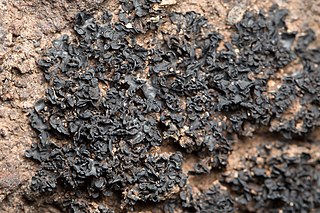Biatorellaceae is a family of lichen-forming fungi in the subclass Lecanoromycetidae. The family is monotypic, and contains the single genus Biatorella, which contains eight species.

Pseudevernia is a genus of foliose lichens in the family Parmeliaceae. The type species of the genus, Pseudevernia furfuracea, has substantial commercial value in the perfume industry.

The Lichinaceae are a family of ascomycete fungi. Most species are lichenized with cyanobacteria, and have a distribution largely in temperate regions.

Ochrolechia is a genus of crustose lichens in the family Ochrolechiaceae.

Trapelia is a genus of lichenized fungi in the family Trapeliaceae.
Gymnographopsis is a genus of lichen-forming fungi in the family Redonographaceae.

Xanthoria is a genus of lichenized fungi in the family Teloschistaceae. Common names include orange lichen, orange wall lichen, and sunburst lichen. They can be identified by their characteristic squamulose morphology with distinctive "fairy cups".

Gyalecta is a genus of lichen-forming fungi in the family Gyalectaceae that contains 50 species. Gyalecta was circumscribed by lichenologist Erik Acharius in 1808. It forms associations with Trentepohlia algae.
Leciophysma is a genus of cyanolichens in the family Pannariaceae. It has four species. The genus was circumscribed by Theodor Magnus Fries in 1865, with Leciophysma finmarkicum assigned as the type species.

Rhizocarpon is a genus of crustose, saxicolous, lecideoid lichens in the family Rhizocarpaceae. The genus is common in arctic-alpine environments, but also occurs throughout temperate, subtropical, and even tropical regions. They are commonly known as map lichens because of the prothallus forming border-like bands between colonies in some species, like the common map lichen.

Bunodophoron is a genus of lichen-forming fungi in the family Sphaerophoraceae. The genus has a broad distribution in the Southern Hemisphere, with several species also present in oceanic regions of the Northern Hemisphere.

Varicellaria is a genus of crustose lichens. It is the only genus in the family Varicellariaceae.

Opegraphaceae is a family of lichen-forming and lichenicolous fungi in the order Arthoniales. It was originally proposed by German lichenologist Ernst Stizenberger in 1862. It fell into disuse, but was resurrected in a molecular phylogenetic study of the order Arthoniales published in 2010. It now includes taxa that were previously referred to the family Roccellaceae, its sister group.

Melaspilea is a genus of lichen-forming and lichenicolous fungi in the family Melaspileaceae. The genus was circumscribed by Finnish lichenologist William Nylander in 1857.

Schaereria is a genus of lichen-forming fungi. It is the sole genus in the family Schaereriaceae, which itself is the only family in the Schaereriales, an order in the subclass Ostropomycetidae of the class Lecanoromycetes. Most Schaereria species are crustose lichens that live on rocks. Schaereria was first proposed by Gustav Wilhelm Körber in 1855 and was later taken up by other lichenologists despite periods of disuse.

Mastodia is a genus of lichen-forming fungi in the family Verrucariaceae. It has six species.
Aspiciliopsis is a genus of lichen-forming fungi in the family Trapeliaceae. It has two species, both of which occur in the Southern Hemisphere.
Follmannia is a genus of lichen-forming fungi in the family Teloschistaceae. It has three species. All three species are crustose lichens, and all occur in South America.
Ionaspis aptrootii is a species of saxicolous (rock-dwelling), crustose lichen in the family Hymeneliaceae. It occurs in New Guinea and Thailand.













